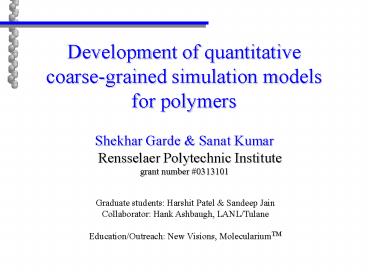Development of quantitative - PowerPoint PPT Presentation
Title:
Development of quantitative
Description:
Title: PowerPoint Presentation Author: Trial User Last modified by: Shekhar Created Date: 9/20/2003 12:17:03 AM Document presentation format: On-screen Show – PowerPoint PPT presentation
Number of Views:81
Avg rating:3.0/5.0
Title: Development of quantitative
1
Development of quantitative coarse-grained
simulation models for polymers
Shekhar Garde Sanat Kumar Rensselaer
Polytechnic Institute grant number 0313101
Graduate students Harshit Patel Sandeep
Jain Collaborator Hank Ashbaugh,
LANL/Tulane Education/Outreach New Visions,
MoleculariumTM
2
Motivation
Applications
Polymer blend phase behavior -
Miscibility/immisciblity of polyolefins
Self-assembly of block copolymers to form novel
micro-structured materials
3
Hierarchy of Length and Time Scales
molecular scale
polymer coil
polymer melt/continuum
gt 100 Å O(1sec)
persistance length 10Å
100 Å 10-8 to 10 -4 sec
bond length 1Å
10 -15 to 10-12 sec
4
Coarse-graining
Examples Lattice models or bead-spring chains,
dissipative particle dynamics methods
Basic idea Integrate over (unimportant) degrees
of freedom
How do we coarse-grain atomically detailed
systems without a significant loss of chemical
information? Do coarse-grained systems provide
correct description of structure, thermodynamics,
and dynamics of a given atomic system?
5
Coarse-graining of Polymer Simulations
Goal To develop coarse-grained descriptions to
access longer length and timescales
How do we derive physically consistent particle-pa
rticle interaction potentials?
Coarse-grained description (t)
Coarse-grained description (t dt)
Future work
One CG particle describes n carbons of the
detailed polymer
Basic idea
Atomistic system ( t )
Atomistic system ( t dt )
6
Coarse-graining method
Perform molecularly detailed simulations of
polymers Define coarse-grained beads by
grouping backbone monomers Calculate
structural correlations between coarse-grained
beads Determine effective bead-bead
interactions that reproduce coarse-grained
correlations using Inverse Monte Carlo --
uniqueness?
7
Detailed molecular dynamics simulations
Classical molecular dynamics n-alkanes - C16
to C96 (M. Mondello et al. JCP 1998) 50 to
100 chains T 403K P 1 atm time 5 to
10 ns
8
Coarse-graining intermolecular correlations
structural details are lost with increasing the
level (n) of coarse-graining process
9
Coarse Graining Intramolecular Correlations
13-intra
12-intra
14-intra
10
Inverse Monte Carlo simulation
g(r) gtarget(r) ?
No
Yes
11
Coarse Grained Potential
inter-bead interaction
intra-bead interaction
Etotal Einter Eintra
Spairsjinter(r) S12pairsj12intra(r)
S13pairsj13intra(r) S14pairsj14intra(r) ...
12
Inter-bead Interactions
before IMC
after IMC
inter-bead radial distribution function
effective interaction potential
13
Intra-bead Interactions
14-intra-bead interactions
13-intra-bead interactions
12-intra-bead bonded interactions
j14(r)
j13(r)
j12(r)
potential (kT)
r (Å)
r (Å)
r (Å)
14
Oligomer conformation distribution
radius of gyration distribution for C96
P(Rg)
Rg (Å)
CG method reproduces conformational statistics of
molecular oligomers
15
Radius of Gyration and Effect of Temperature
503K 0.40 0.42
CG
excellent agreement with experiment
16
Polymer Conformation Distribution
radius of gyration distribution (403K)
C96 C1000 C8000 ideal
P(Rg)
Rg Rg / lt Rg2 gt1/2
polymer conformational space efficiently explored
17
Buckyball Polymer Nanocomposites
bead-ball distribution
bead-ball interaction
g(r)
j (kT)
r (Å)
r (Å)
18
Conclusions
CG method maps molecular scale correlations to
coarse-grained potentials Coarse grained
potential simpler than molecular potential and
can be extended to polymer simulations while
preserving molecular identity Not limited to
polymeric species (e.g., buckyballs/
nanocomposites) Path Forward - Polyolefin
blends - Block copolymer assembly - Dynamics?
19
Water molecule
Hydra H atom
Biological world
Mr. Carbone
20
Thank you!












![⚡[PDF]✔ Research Design in Aging and Social Gerontology: Quantitative, Qualitative, PowerPoint PPT Presentation](https://s3.amazonaws.com/images.powershow.com/10051225.th0.jpg?_=20240608119)


















